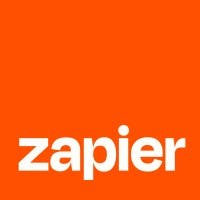Thesis
In 2024, 81% of shoppers conducted online research before making a purchase, reflecting the growing trend of digital engagement in retail. In 2023, over 73% of small businesses in the U.S. maintained a website, compared to only 50% in 2018, indicating an increasing reliance on online presence to boost brand exposure and drive sales. This shift towards online channels is supported by the fact that the global ecommerce market has a forecasted CAGR of 14.9% between 2024 and 2034, resulting in a projected market volume of $36 trillion by 2026.
Despite this growth, many users face challenges in establishing and managing their online presence. Traditional website-building tools require technical knowledge, making it difficult for non-developers to create and maintain websites effectively. Moreover, the average cost of designing a small business website ranges from $2K to $9K. A Content Management System (CMS) addresses these challenges by enabling users to create, edit, and manage website content without extensive coding skills, simplifying website maintenance for small business owners.
Automattic is a web development company that focuses on making online content creation and management accessible to a broad audience. Founded in 2005, it operates WordPress.com, which powers over 43% of all websites globally, providing users with tools to easily build and maintain their sites. Additionally, Automattic offers WooCommerce, an ecommerce plugin that enables businesses to sell products and services online from their WordPress websites. Automattic’s mission is to “democratize publishing and commerce”, ensuring that anyone can have an online presence.
Founding Story
Automattic was founded in 2005 by Matt Mullenweg (CEO), when he was 20 years old. Mullenweg's involvement in the blogging space began as an early adopter, when in 2003, he expressed frustration in a blog post about the lack of updates to his blogging software, noting that the "main developer had disappeared.” Later that year, Mullenweg and Mike Little, a web developer, co-founded the open-source WordPress project. WordPress provides a user-friendly content management system with a mission of providing accessibility, performance, security, and ease of use, supported by a global community of open-source contributors.
Mullenweg's early work on the WordPress project gained traction, with over 29K blogs using the platform by October 2004. This growth caught the attention of CNET, which offered him the opportunity to drop out of the University of Houston and join the media company, allowing him ownership of the source code he had written.
While still at CNET, Matt Mullenweg built Akismet, a spam-filtering tool for blogging platforms. Recognizing the commercial potential of Akismet, Mullenweg then left CNET to found Automattic, hiring contributors he had collaborated with on the volunteer-driven open-source WordPress project. Automattic embraced a remote-friendly approach from its inception, which was unusual for companies at the time, and according to Mullenweg, “turned a lot of investors off.”
The company started working on WordPress.com, a commercial counterpart to the open-source WordPress project. Mullenweg faced the challenge of being a young founder with no prior successes. He was connected with Toni Schneider, a former Yahoo executive, who was hired as Automattic's CEO six months after the company was founded, a position he held until 2014. Mullenweg describes Schneider as his "business soulmate" and credits him as key to Automattic's growth beyond its original offerings of Akismet and WordPress.com.
Automattic deliberately avoided marketing and advertising, focusing instead on expanding its offerings beyond personal blogging into small business websites and enterprise hosting. VIP, which was a pricing tier offered by WordPress.com with greater support and security features, was spun off into an independent business line in 2011.
In 2011, Automattic also introduced Jetpack, a product that brought the cloud-powered capabilities of WordPress.com to self-hosted WordPress.org sites. As Automattic grew, the company began granting more autonomy to some of its divisions, such as VIP and Jetpack, allowing them to develop their own independent leadership structures.
In 2015, Automattic made a strategic acquisition of WooCommerce, an ecommerce plugin for WordPress, further diversifying its product portfolio. As of February 2025, Automattic has grown to ~1.7K employees, called "Automatticians," spread across 90 countries.
Product
Automattic’s full suite includes more than 17 products, the most notable of which include WordPress.com, WooCommerce, Tumblr, Akismet, and Jetpack. While some products like WordPress and Akismet were built within Automattic, most of the product suite has been acquired. Automattic’s products operate in the internet publishing, ecommerce, social networking, journaling, and blogging spaces.
WordPress.com
WordPress.com is an open-source content management system that allows users to create and manage websites and blogs. Unlike the self-hosted version WordPress.org, WordPress.com users get web hosting, maintenance, and security features within the platform, and is used on 160 million websites as of February 2025. Compared to WordPress.org, WordPress.com offers fewer customization options, restricted site monetization choices, and does not allow custom plugins. It offers domain name purchase and transfer ability to users with an active account. WordPress.com's ecosystem includes these key offerings:
WordPress Hosting: A specialized web hosting service optimized for WordPress websites, it includes features like real-time backup, automated burst scaling, and security measures like SSL certificates. This type of hosting comes with WordPress-specific technical support and added Jetpack features. WordPress Hosting also allows users to incorporate WooCommerce payment features.
WordPress for Agencies: Aimed toward digital agencies and web developers who manage multiple websites for clients, WordPress for Agencies provides access to discounted pricing, referral earnings, and bundled services from Automattic’s product suite. Other features include dashboards for client management and white-labeling options.
P2: P2 is a WordPress theme that transforms a standard WordPress site into a real-time, asynchronous communication platform. It enables teams to share updates, discuss ideas, and collaborate on projects. It also supports more than 20 integrations with collaboration softwares like Figma, GitHub, Vimeo and Loom.
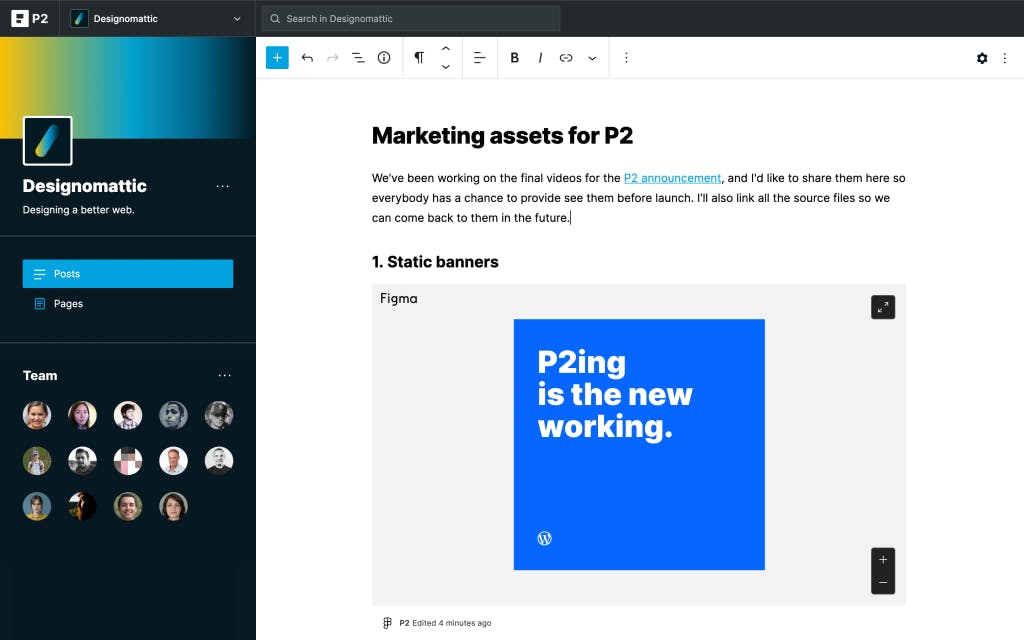
Source: P2
Website Design Services: This product offering involves expert designers and developers who create WordPress websites tailored to a client's specific needs. It includes services like customized layout design, learning management systems, and ecommerce setup. These services extend to providing site-specific documentation, custom integrations, and revisions for refinement.
WordPress VIP: WordPress VIP provides scalable WordPress hosting for large-scale websites and applications. It caters to enterprise clients, major digital publishers, and high-traffic websites, including Al Jazeera, Salesforce, and Hello Fresh. It offers features like real-time content deployment, content analytics, and enterprise-grade security. The pricing for this product starts at $25K per year and can vary based on monthly anticipated traffic and customer success needs.
Professional Email: This product allows users to get a custom domain and personalized email address to enhance brand recognition. It utilizes an email platform built by Titan, a business email hosting service.
WooCommerce
WooCommerce is an open-source ecommerce platform that can transform a WordPress site to an online storefront, used by 3.7 million stores as of February 2025. To build an online store using WooCommerce, a user will first pick a hosting provider and then download or activate the WooCommerce plugin. While WooCommerce is offered for WordPress websites, it can also be used with hosting providers like Bluehost, Nexcess, and SiteGround. WooCommerce provides tools to manage products, process orders, handle payments, and customize storefront themes on both desktop and as a mobile app:
Payments & Checkout: This feature allows WooCommerce users to accept in-person and online payments, receive flexible financing, and manage payment activity from a dashboard. It is available in 38 countries and accepts payments in more than 135 currencies. This solution handles payment authorization and supports various payment methods including credit cards, Apple Pay, Google Pay, and express checkout options like WooPay. Woo Mobile App also allows sellers to accept in-person contactless payments. By using WordPress’ built-in block editor and integrating with WooPayments, sellers can customize checkout blocks.
Block Themes: This feature allows store owners to customize their online shop's appearance and functionality using visual editors and pre-built options. Users can modify store layouts and adjust product displays using drag-and-drop builders, customization panels, and pre-designed templates.
Marketing: WooCommerce marketing solutions allow integration of storefronts with third-party marketplaces, email marketing, coupons and discount management systems, and search engine optimization.
Shipping: Integration with USPS and DHL allows sellers to print labels from within the WooCommerce dashboard on desktop or mobile app.
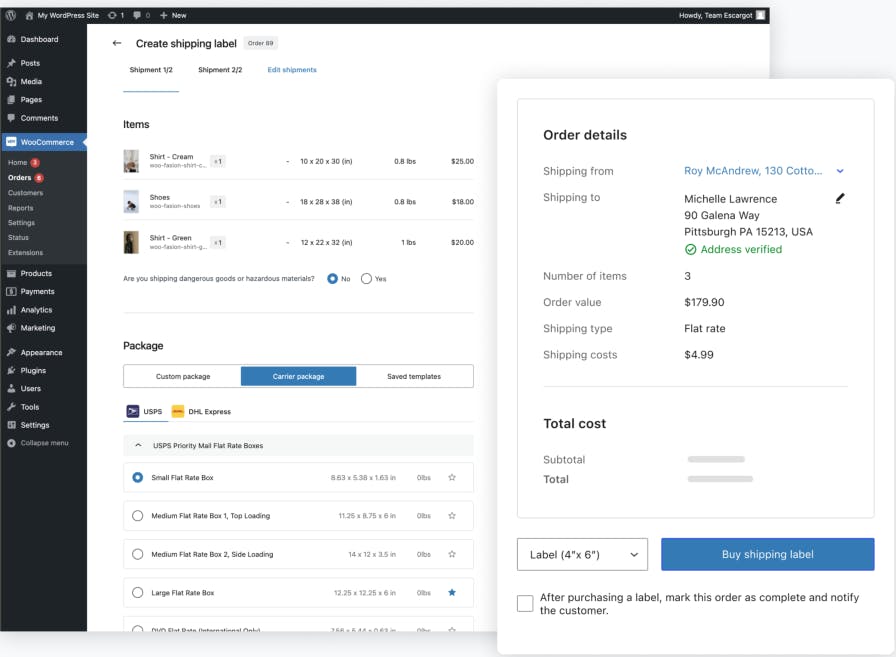
Source: WooCommerce
Enterprise Ecommerce: For clients with high-volume stores Woo Enterprise offers data migration, discounted hosting, and CRM integration capabilities.
Tumblr
Tumblr is a microblogging and social networking platform that allows users to post multimedia content to a short-form blog, with an emphasis on creativity and self-expression. Users can create and customize their own blogs on Tumblr, posting various types of content including text, images, GIFs, videos, and audio. The platform supports reblogging, allowing users to share and comment on posts from other blogs they follow. Tumblr's dashboard acts as a personalized feed, displaying posts from followed blogs in chronological order.
Tumblr offers customization options for blog appearance, including themes and layouts. The platform includes a tagging system for content discovery and a search function to find specific posts or blogs. Users can interact through likes, comments, and private messaging. Tumblr also provides mobile apps for iOS and Android.
Tumblr supports post-scheduling and queue management for planned content releases. It also offers analytics for bloggers to track their post performance and audience engagement. Account creation is free, but Tumblr generates revenue through advertising and offers paid features like Blaze to promote content.
Jetpack
Jetpack is a plugin that enhances WordPress sites with security, performance, growth, and management features. As of February 2025, it is used by 27 million WordPress sites:
Security: Jetpack Security provides solutions like real-time backups, automated malware scanning, and spam protection. The service includes features like brute force attack prevention, downtime monitoring, and secure authentication.
Performance: Designed to optimize websites for speed and efficiency, Jetpack Performance tools include a Content Delivery Network (CDN) for faster image loading and optimized video hosting. This feature set also provides tools for CSS and JavaScript optimization through Jetpack Boost, and search and indexing solutions.
Growth: Jetpack Growth includes social media automation for sharing content across various platforms and email marketing tools for subscriber management and newsletters. It also offers site statistics for tracking visitor behavior through Jetpack Stats, and advertising content across WordPress.com and Tumblr ad network through Blaze.
Management: Jetpack Management allows users to monitor site security, traffic, and performance from a centralized dashboard for multiple WordPress sites. The service includes automated plugin updates, downtime monitoring, and site traffic trend analysis.
Akismet
Akismet is a spam filtering service developed by Automattic to protect WordPress sites from comment and trackback spam. It is platform-agnostic and offers integration with plugins like Jetpack. When activated, Akismet processes each comment submitted to a site through its algorithm to determine if it's likely to be spam. Legitimate comments are posted, while suspected spam is either automatically discarded or held for review, depending on the user's settings. Site administrators can review filtered comments in their dashboards and mark false positives to improve the system's accuracy. Akismet provides statistics on spam blocked and the accuracy of its filtering through a dashboard. It offers both free and paid plans, as well as APIs for developers to integrate its spam-checking capabilities into their own applications or plugins. As of February 2025, Akismet had removed over 500 billion spam messages and is used on more than 100 million websites.
Broader Product Portfolio
In addition to WordPress, WooCommerce, Tumblr, Jetpack, and Akismet, Automattic also has 12+ additional products in its portfolio:
Crowdsignal: An interactive survey and polls product. Automattic acquired the company, PollDaddy, in November 2008. In October 2018, Automattic acquired the domain Crowdsignals.com, rebranded PollDaddy, and relaunched the product.
Simplenote: A note-taking application built with markdown support and available across iOS, Android, Mac, Windows, Linux, and browser. Automattic acquired Simplenote parent company, Simperium, in 2013.
The Atavist: A magazine focused on long-form narratives, publishing “one incredible true story every month.” The Atavist was acquired by Automattic in June 2018. Previously, The Atavist Magazine had also built the Atavist publishing platform to provide similar publication capabilities to other users, but was retired in 2021 and migrated to Newspack.
Newspack: A publication platform focused on enabling news organizations. The product is a “project of WordPress.com, with support from the Google News Initiative, the Knight Foundation, and The Lenfest Institute.” The product includes functionality around flexible publication, reader activation, and ad solutions. Automattic announced the launch of the product in January 2019.
Pocket Casts: A podcasting platform that provides listening, discovery, and curation. Automattic acquired Pocket Casts in July 2021.
Texts.com: A chat aggregation app, built on open-source. Texts supports services like iMessage, WhatsApp, Instagram, and Signal, allowing users to manage multiple conversations seamlessly. Automattic's CEO, Matt Mullenweg, emphasized the company's commitment to open-source solutions and enhancing communication tools. Automattic acquired Texts in October 2023.
Each product revolves around the overall mission Automattic states explicitly: “Our common goal is to democratize publishing and commerce so that anyone with a story can tell it, and anyone with a product can sell it, regardless of income, gender, politics, language, or where they live in the world.”
Market
Customer
WordPress caters to a wide spectrum of users, from personal bloggers and hobbyists to small and medium-sized businesses to large enterprises. It began with a focus on customers who wanted to focus on content rather than managing web servers. As of February 2025, WordPress customers include Condé Nast, TechCrunch, Samsung, and Meta, with more than 43% of the web being hosted on WordPress.
WooCommerce, Automattic's ecommerce plugin for WordPress, caters to small and medium businesses. The company started in 2007 as a theme-builder for WordPress sites. In 2011, it transitioned to a plugin, allowing users to add ecommerce functionality to their WordPress sites. WooCommerce is used by 3.7 million, as of February 2025, and includes customers like NutriBullet, Airstream, and Springboks. Directly competing with Shopify, WooCommerce positions itself as more developer-oriented as an open-source platform, allowing customizability.
Automattic's acquisition of Tumblr has allowed the company to expand its reach into the broader content creation and social media landscape. Founded and launched in 2007, Tumblr focused on allowing users to incorporate multimedia instead of text-heavy posts, helping set it apart from competitors including X and Facebook. Tumblr caters to a diverse community of individuals, artists, publishers, and organizations. As of January 2025, Tumblr had 135 million monthly active users, with 48% of its active users being Gen Z.
Market Size
The market opportunity for Automattic and its suite of products spans several sectors like website building and content management, ecommerce, and social media.
The content management software market was projected to reach $22.1 billion in 2024. It is expected to grow at a CAGR of 4.9%, reaching a market volume of $28 billion by 2029. As of February 2025, WordPress holds 61.8% of the content management system market.
The global ecommerce market has a forecasted CAGR of 14.9% between 2024 and 2034, resulting in a projected market volume of $36 trillion by 2026. The ecommerce platform market is a subset of the ecommerce market, focusing on software solutions that businesses use to manage online stores. As of September 2024, WooCommerce held a 20.1% market share in the ecommerce platform market, which was valued at over $9 billion in 2024. Optimized online experience, increase in mobile device usage for shopping, and government support for businesses building an online presence are factors contributing to the growth in this market.
Social media platforms also allow for targeted advertising, leading to a direct increase in ecommerce sales. The social media market size was estimated at $219 billion in 2023 and is forecasted to grow to $413.1 billion by 2028 at a CAGR of 13.2%. Growth in this market is driven by increasing internet penetration, the rise of the creator economy, increasing demand for niche content, and the growth of digital advertising avenues.
Competition
Automattic provides a suite of web publishing and e-commerce tools designed to meet the needs of website owners, bloggers, and online businesses. Its product ecosystem enables users to start with a basic blog and grow into a full-featured ecommerce platform, fostering customer loyalty and increasing switching costs as users become more embedded in the Automattic ecosystem.
However, competitors with specialized offerings often deliver advanced features or target niche markets more effectively. For instance, Shopify’s offering is more suited than WooCommerce for businesses without technical staff. Across Automattic's product portfolio, there are a number of relevant competitors:
WordPress.com: Wix, Squarespace, Webflow
WooCommerce: Shopify, BigCommerce
Tumblr: Substack, Medium, Pinterest
Jetpack: Yoast SEO, Elementor, WP Rocket
Akismet: CleanTalk, Antispam Bee, SpamShield
Wix: Founded in 2006, Wix is a drag-and-drop website builder for ecommerce, businesses, and individuals. In 2023, it reported a revenue of $1.7 billion. The company is publicly traded with a market cap of $12.2 billion and over 200 million users globally, as of February 2024. With more than 60K plugins, WordPress allows for greater design and functionality flexibility, compared to Wix. To compete more directly with WordPress’s flexibility, Wix launched Editor X (now Wix Studio) in 2020, which provides design freedom and responsive controls for advanced users. As a content management system, Wix holds 4.9% of the market share, as of February 2025.
Squarespace: Founded in 2003, Squarespace is a website-building platform geared toward small businesses and individuals looking to create ecommerce or blog sites. In 2023, the company reported 4.6 million unique subscriptions. In 2023, it acquired Google Domains, in a deal valued at $180 million. Unlike WordPress, which started as a blogging platform and evolved into a flexible content management system, Squarespace is more focused on providing a template-driven experience. In October 2024, Squarespace was acquired by Permira for $7.2 billion with the company forecasting $1.2 billion of revenue in 2024.
Webflow: Webflow is a platform designed for users who want more direct control over the visual aspects of their websites, offering advanced design tools and a drag-and-drop interface. It was founded in 2012, and raised a $120 million Series C in March 2022 at a valuation of $4 billion, bringing the company’s total funding to $330 million. This round was led by Y Combinator, with participation from existing investors like CapitalG, Accel, Silversmith, and Draper Associates. While Webflow provides more design-focused tools, WordPress.com is typically better suited for content management and customization through its ecosystem of plugins. Both platforms support ecommerce, blogging, and CMS features.
Shopify: Founded in 2006, Shopify is an ecommerce platform for businesses of all sizes. As of February 2025, the company had a market cap of $165 billion and recorded a revenue of $8.9 billion in 2024. The company held a 17.5% market share in the ecommerce platform category, as of February 2025, second only to WooCommerce. Unlike WooCommerce, which is an ecommerce plugin designed for WordPress sites, Shopify is a standalone solution that provides services like hosting, integrated payments solution, and multichannel selling. Both platforms offer security features like SSL certificates, but Shopify provides more pre-packaged compliance and security solutions. Unlike Shopify, WooCommerce is open-source and self-hosted, giving users more control over their store's backend.
Medium: Medium was founded in 2012 by Ev Williams, one of X’s (formerly Twitter) co-founders. It is a platform that allows users to publish long-form articles, essays, and stories. As of February 2025, Medium had over 100 million monthly visitors and had raised a total of $163 million. Investors in Medium include Andreessen Horowitz, Spark Capital, and Greylock. Medium competes with both Tumblr and WordPress, especially by catering to writers and readers through its structured platform. Tumblr’s focus on multimedia features differentiates it from Medium. Unlike Tumblr, Medium offers limited customization options, making it better suited to readers and writers with limited technical knowledge.
Business Model
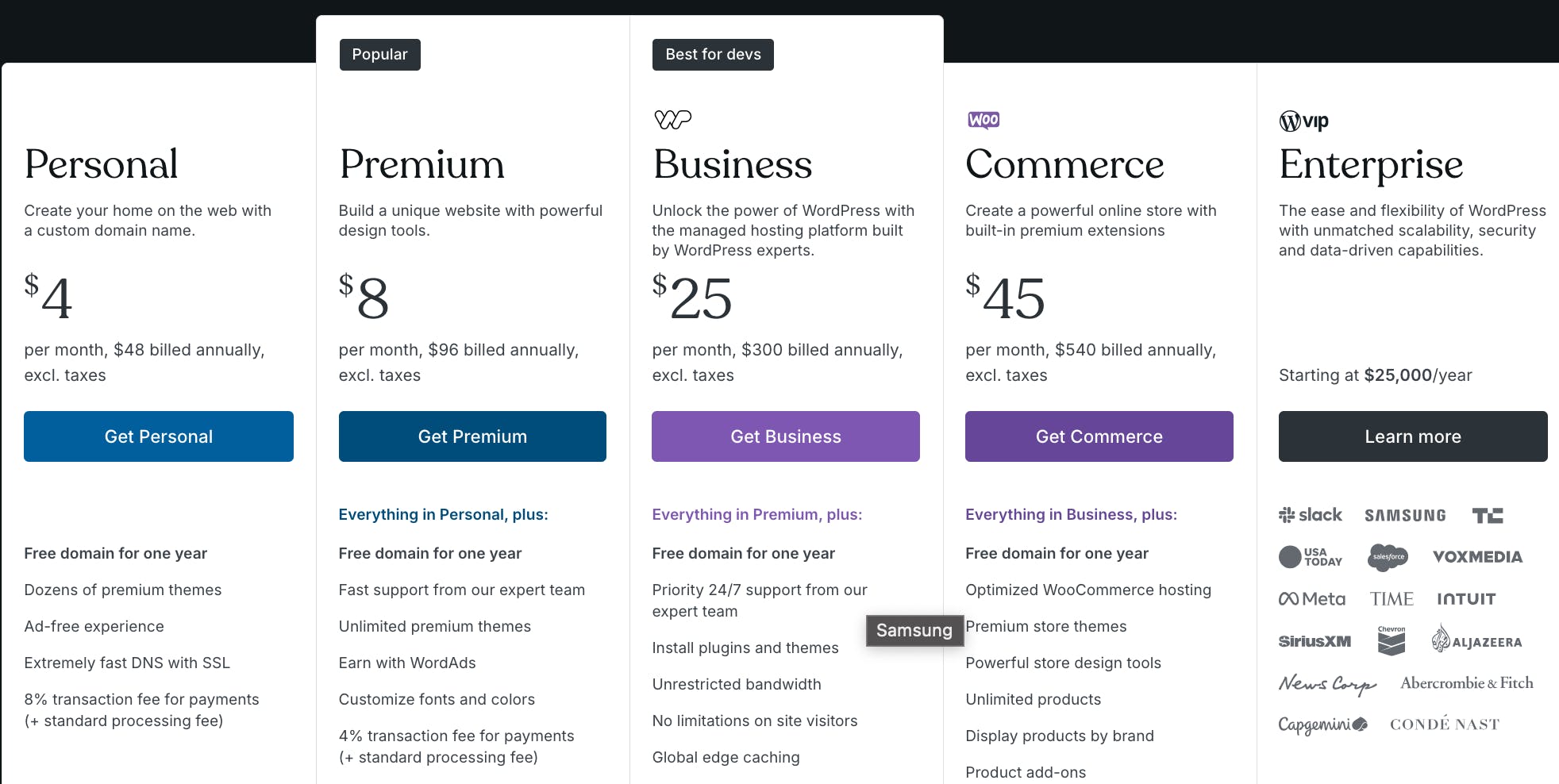
Source: Wordpress.com
WordPress.com operates on a freemium model. The free plan includes a WordPress.com subdomain 3GB of storage, and essential Jetpack features.
The paid plans start at $4 per month, billed annually, for the Starter plan, which provides a free custom domain for the first year, 6GB of storage, and the ability to remove ads. The Explorer plan at $8 per month adds features like Google Analytics integration, advanced SEO tools, and the ability to earn ad revenue
The $25 per month Creator plan includes more customization options, including installing custom plugins and themes, 200 GB of storage, and automated site backups
At the higher end of the paid plans, the $45 per month Entrepreneur plan is geared towards online stores, providing ecommerce marketing tools, unlimited products, and integrations with top shipping carriers
The $65 per month Cloud plan offers a managed, cloud-based WordPress platform, offering solutions for customers with high-traffic websites. Features include isolated site infrastructure, centralized site management, and 24/7 priority support
The final Enterprise plan is offered as a WordPress VIP service, has customized pricing, and customers include Slack, Disney, CNN, and Bloomberg
WooCommerce
WooCommerce itself is a free and open-source plugin that can be added to a WordPress website. However, to run a full-fledged WooCommerce online store, there are various additional costs and services that store owners need to pay for, including:
Domain name, which costs $15 on average
Premium themes, which can go up to $100
If WooPayments, the inbuilt payment gateway is used, the transaction fee is 2.9% + $0.30 for every purchase. Customers can also use Stripe, Paypal, or Authorize.net at different pricing
Email marketing tools, which can range from free to $119 per year
Security plugins, such as Jetpack, which can also range from free to $239 per year
Tumblr
Tumblr allows users to create an account and publish content for free. There are no hosting or subscription fees required to use the platform. However, users can turn off ads by getting an ad-free subscription, priced at $4.99 per month, or $39.99 per year.
Jetpack

Source: Jetpack
Jetpack operates on a freemium model, with one free and two paid tiers:
The free Jetpack plan includes basic features such as downtime monitoring, secure authentication, and SEO tools
The $9.95 per month Security plan offers additional features like real-time backups, the ability to collect payments at lower transaction fees, and a longer activity log
The $24.95 per month Complete plan offers supplementary features like instant site search, all CRM extensions, and larger activity log, and real-time backup storage
Users can also separately purchase individual products like anti-spam, stats, and backup
Akismet
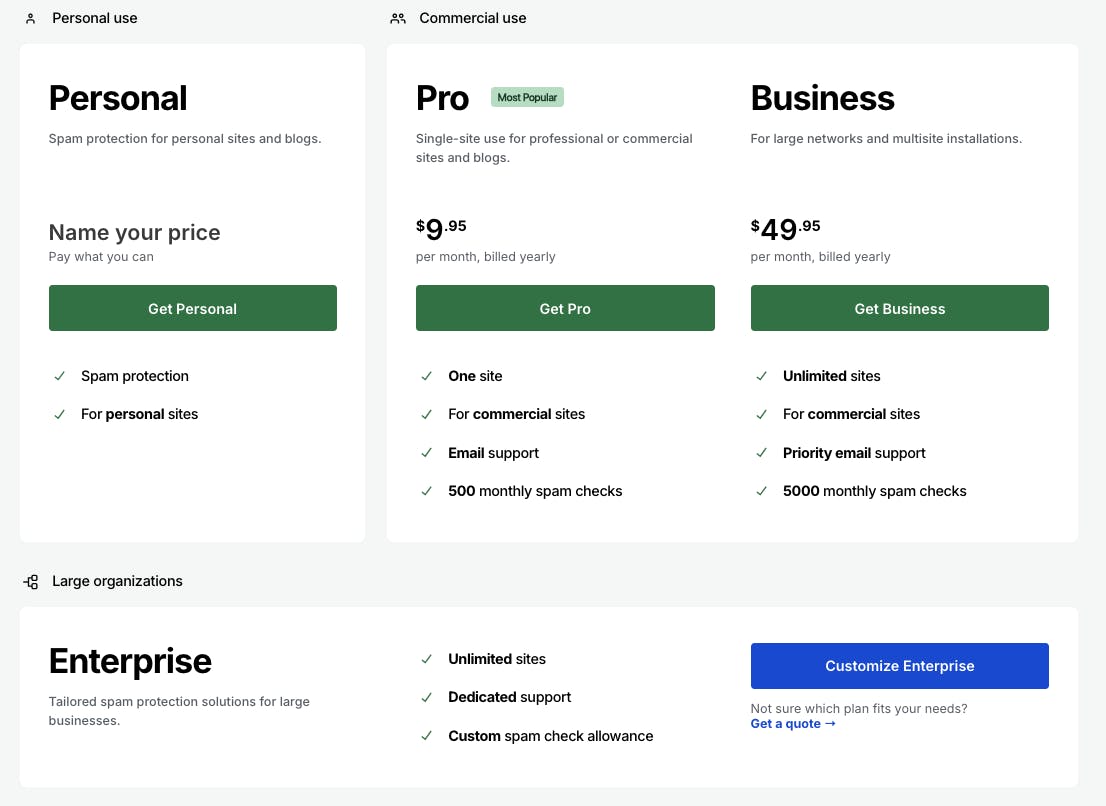
Source: Akismet
Akismet also operates on a freemium model:
The free Akismet Personal plan is available for non-commercial, personal blogs
The Akismet Pro plan, at $9.95 per month, is designed for small businesses and commercial sites, covering one site and 500 monthly spam checks
The Akismet Business plan, at $49.95 per month, is tailored for large businesses, supporting unlimited sites and 5K monthly spam checks
Akismet also offers custom pricing for Enterprise clients
All paid plans include features such as automatic spam filtering, comment moderation tools, and detailed spam statistics
Traction
Automattic acquired Beeper, a cross-platform messaging solution, for $125 million in April 2024. This acquisition was preceded by acquiring Beeper’s competitor Texts for $50 million in October 2023. As of April 2024, Beeper had 115K users and 466K people on its product waitlist.
In June 2024, the company announced Automattic for Agencies, a centralized dashboard that allows customers to control multiple client sites. Designed for medium-sized agencies, this program also offers increased earnings to customers through revenue share on product referrals.
As of September 2024, Tumblr has a total of 606 million blogs. In August 2024, the company announced moving Tumblr’s backend to WordPress. According to the announcement, the decision will benefit Tumblr by running on “rock-solid infrastructure behind WordPress.com”.
Among Automattic's product suite, WordPress.com, WooCommerce, Jetpack, and Tumblr are the top four platforms by user base. As of September 2024, WordPress.com powers more than 43% of the web, WordPress websites host 409 million unique visitors each month, and Jetpack is used on 27 million WordPress sites. WooCommerce is used by more than 3.9 million stores as of September 2024. According to one unverified estimate, Automattic reached revenue of $220 million in 2023.
Valuation
In February 2021, Automattic raised a $288 million round of funding, led by Alta Park Capital, BlackRock, and other investors like Wellington Partners, Schonfeld Strategic Advisors, and ICONIQ. The round brought the company’s total funding amount to $985.9 million. At the same time, the company also did a $250 million share buyback at a $7.5 billion valuation. Prior to this round, Automattic raised a $300 million Series D in September 2019, led by Salesforce Ventures. Automattic has pursued a conservative fundraising strategy since its founding. Before its 2019 and 2021 rounds, the company's last major investment was a $160 million Series C in 2014.
Key Opportunities
Expansion Into Messaging
With the acquisition of competitors Texts in October 2023, and Beeper in April 2024, Automattic is investing into it’s “third pillar”. According to Mullenweg:
“Self-publishing, commerce, and messaging covers a good chunk of all human activity, and they’re also three areas where I think an open-source solution is necessary for the long term.”
There have been no major chat applications launched since 2015, with the release of Discord. When it was acquired, Beeper had over 115K users and 466K people on its waitlist, which indicates the market demand for chat platforms that incorporate multiple messaging services. Since Beeper is built on top of the open-source messaging protocol Matrix, developers can create custom clients for the app. Beeper is expected to generate revenue via a premium subscription.
Scaling Open Source Offerings
According to Mullenweg, “[embracing] open source makes things super user centric”. Building on acquisitions like Tumblr and Pocket Casts, Automattic has opportunities to develop open-source offerings for multimedia content creation, publishing, podcasting, and digital storytelling experience. In July 2023, Automattic open-sourced stream-builder, the algorithm that powers Tumblr dashboards. In January 2024, Mullenweg announced the Data Liberation project, an initiative to facilitate data and content movement between different platforms and into WordPress with minimal friction. The initiative encourages sharing migration resources like plugins, scripts, and guides as community-owned open-source assets.
Key Risks
Content Sharing With AI Partners
In February 2024, reports claimed that Automattic would provide AI companies Midjourney and OpenAI with training data scraped from users’ posts. Based on its policies, Automattic specified that it will allow sharing content hosted on WordPress.com and Tumblr with its AI partners if the content is public and from sites that haven’t opted out. Tumblr’s diverse user base includes artists, who have opposed the alleged misuse of their copyrighted works by AI companies.
Monetization Strategies
Automattic announced in November 2023 that Tumblr will have smaller teams focused on providing core functionality. This shift in approach was attributed to less-than-expected revenue and usage numbers. After being carved out of Verizon in 2019, monetization strategies for Tumblr include Live, a sponsored post feature called Blaze, an ad-free subscription, and a paid content feature called Post Plus.
In March 2024, Bluehost, a web hosting and domain registration company announced a partnership with WP Cloud. WP Cloud is a cloud platform that offers performance, security, and management solutions specifically for WordPress websites. Amidst bets on and ventures into messaging, Automattic’s platform-as-a-service offering is a revenue diversification strategy.
Summary
Automattic has strategically expanded by acquiring businesses like Tumblr and Texts, which positions the company to address three critical areas of online interaction: content creation, ecommerce, and messaging. This complements its existing offerings, such as WooCommerce and Jetpack, which are plugins used on the core product WordPress.com. As a leader in the website-building market, Automattic benefits from a broad customer base across individuals, small businesses, and enterprise clients. However, it faces challenges in establishing effective monetization strategies for its acquisitions while maintaining its commitment to open-source principles.


